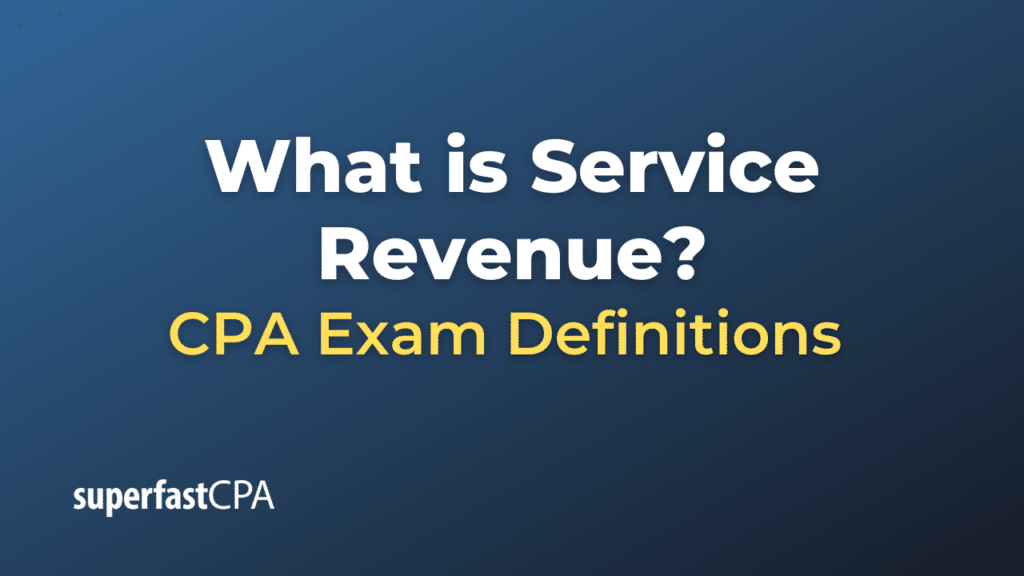Service Revenue
Service revenue refers to the income a company generates by providing services, as opposed to selling physical goods or products. It represents the primary source of revenue for businesses in the service industry, which encompasses a wide range of sectors, from professional services like consulting and legal advice to personal services such as beauty salons, and from digital services like software-as-a-service (SaaS) to more manual offerings like plumbing or house cleaning.
Here’s a breakdown of key points about service revenue:
- recognition: In accounting, the recognition of service revenue is based on when the service is rendered or performed, rather than when payment is received. The principles of accrual accounting dictate that revenue should be recognized when it is earned, regardless of when payment is made.
- Income Statement: On a company’s income statement, service revenue usually appears at the top as it represents the primary income source before any expenses are deducted. It’s crucial for understanding a service company’s primary earning power.
- Difference from Product Revenue : For companies that both sell products and provide services, the revenue from each source will typically be listed separately on the income statement. This distinction ensures clarity in understanding different revenue streams and assessing the profitability of each.
- Deferred Revenue: If a service company receives payment before the service is performed (common with subscription-based services), this is recorded as deferred revenue (a liability). It’s only recognized as service revenue on the income statement when the service has been provided.
- Profit Margins: Often, service revenue can carry higher profit margins than product sales, especially for services that don’t require significant ongoing costs. For instance, once a software product is developed, selling subscriptions to access that software (SaaS) can have high margins because the cost of adding a new subscriber is relatively low.
Examples of businesses primarily driven by service revenue include consulting firms, accounting agencies, cloud software providers, repair services, and more. In these cases, the value proposition to the customer is based on expertise, convenience, access, or other non-tangible factors.
Example of Service Revenue
Let’s consider a fictional scenario involving a software-as-a-service (SaaS) company.
Company: CloudTech Solutions
Business Model: CloudTech Solutions offers subscription-based cloud storage services to businesses.
In January 2023, CloudTech Solutions signed contracts with several companies for its premium cloud storage solution. The specifics of the contracts are as follows:
- Alpha Corp purchased a 12-month subscription for $12,000, paying the full amount upfront in January.
- Beta Inc. opted for a monthly payment plan, agreeing to pay $1,200 each month for a 12-month subscription.
- Gamma Ltd. purchased a 6-month subscription for $7,200 in January but requested the service to start in March.
- For Alpha Corp: Although CloudTech received $12,000 in January, it will recognize service revenue of $1,000 each month (i.e., $12,000/12 months) as it provides the cloud storage service throughout the year.
- For Beta Inc.: CloudTech will recognize $1,200 as service revenue each month as it receives the payment and concurrently provides the service.
- For Gamma Ltd.: The $7,200 paid in January will initially be recorded as “Deferred Revenue” in CloudTech’s books. Starting from March, CloudTech will recognize $1,200 as service revenue each month (i.e., $7,200/6 months) over the 6-month period.
By the end of January 2023, CloudTech Solutions would recognize:
- $1,000 from Alpha Corp’s annual subscription (1/12th of the prepaid amount).
- $1,200 from Beta Inc.’s monthly subscription.
- $0 from Gamma Ltd. since the service has not yet started, and the amount remains as deferred revenue.
The total service revenue recognized by CloudTech Solutions for January 2023 is $2,200, with an additional $7,200 recorded as deferred revenue (from Gamma Ltd.) on the balance sheet.
This example highlights how service revenue recognition can be based on when the service is rendered, even if the payment is received upfront or spread out over time. It ensures that revenue is matched with the corresponding period in which the service was provided.













